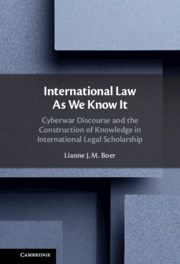 International Law As We Know It
International Law As We Know It Published online by Cambridge University Press: 01 October 2021
This chapter asks how scholars reconstruct the meaning of the prohibition on the use of force in light of the “novel features” (Benatar) of cyberwar. Given the range of effects cyberattacks can have the question is where scholars draw the boundary of force. By creating a dialogue between different pieces and juxtaposing the arguments scholars make, this chapter shows what legal knowledge construction at the boundaries of Article 2(4) looks like. Specifically, it identifies two argumentative turns scholars take. The first pertains explicitly to the boundaries of the norm, and the chapter shows the subsequent trajectory of an argument about the (in)sufficiency of Article 2(4) in regulating these kinds of cyberattacks. The second turn pertains to the classification of the threat. Whereas to some scholars cyberattacks simply constitute a new means to wage war, to others the change is much more fundamental. Whether a scholar opts for the first label or the second, matters to how the legal analysis proceeds towards, again, a diagnosis about the (in)sufficiency of the norm. In sum, this chapter shows how exactly legal writing constructs legal knowledge in relation to Article 2(4).
To save this book to your Kindle, first ensure [email protected] is added to your Approved Personal Document E-mail List under your Personal Document Settings on the Manage Your Content and Devices page of your Amazon account. Then enter the ‘name’ part of your Kindle email address below. Find out more about saving to your Kindle.
Note you can select to save to either the @free.kindle.com or @kindle.com variations. ‘@free.kindle.com’ emails are free but can only be saved to your device when it is connected to wi-fi. ‘@kindle.com’ emails can be delivered even when you are not connected to wi-fi, but note that service fees apply.
Find out more about the Kindle Personal Document Service.
To save content items to your account, please confirm that you agree to abide by our usage policies. If this is the first time you use this feature, you will be asked to authorise Cambridge Core to connect with your account. Find out more about saving content to Dropbox.
To save content items to your account, please confirm that you agree to abide by our usage policies. If this is the first time you use this feature, you will be asked to authorise Cambridge Core to connect with your account. Find out more about saving content to Google Drive.